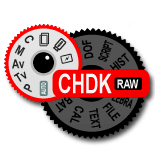CHDK is a set of tools allowing the user full control over the operation of a large number of the cheaper Canon point&shoot cameras. After all, a camera nowadays is more that a box with a hole in it; everything is, of course, controlled by a microprocessor. With suitable access to the processor, the camera becomes like any other universal machine and can be programmed to do what you like with it. I can vividly remember my disappointment when I thought that I could use the time delay function for a sort of limited time lapse, and all the camera did was wait for the set time and take the ten shots in quick succession. If the camera can count to 30 once, why not continue the process.
CHDK has three major components: the CHDK menu itself, and two script interpreters. In order to get it to run, it masquerades as a firmware update, but it does not update the firmware as such, rather it runs like any other program on a computer. It redirects the function of one of the buttons (usually the print button), making it the CHDK menu access button. Have a look at the CHDK page for what it can do; the possibilities are almost limitless.
As with anything of this scope, it is a good idea to write down a list of things you want to achieve before you start and review the list at a later date. There were five things on my list:
- Grid overlay;
- RAW shots;
- Time lapse;
- Motion detection lightning and meteor photography;
- Auto exposure bracketing.
Yes, I achieved all these with a high degree of success; but also much, much more. I was able to use CHDK to take all of the zoom/aperture combinations that I needed to create a comprehensive database of correction factors for barrelling and chromatic aberration. I found I could use the time lapse function to make a standard test of batteries; I was able to produce a series of dark frames for long time exposures (practically up to 256 seconds at ISO 50, after which warmth from the electronics ruins the exposure).
The question everyone wants an answer to in the beginning is: Will CHDK damage the camera? If you’re worried about this, go to ebay and get yourself an A470 for €50 and try it out. If the camera breaks, it’s not worth fixing. Since starting with CHDK, I have taken about 130,000 photos with my 3 cameras, so I am only surprised that the cameras are still going strong. I am also a little surprised that “ordinary” malfunctions have yet to be attributed to CHDK. In any case, if you had a malfunction within the guarantee period, just switch the camera off and put a clean card in it; nobody can tell you were using CHDK at the time the malheur occurred.
With all of these technical questions now clarified there was nothing else to do but to return to New Zealand to rephotograph everything.
Everything.

